#Home Hydroponic Farming System
Explore tagged Tumblr posts
Text

Experience Fresh and Abundant Harvests with the Innovative Home Hydroponic Farming System
The Home Hydroponic Farming System boasts a range of impressive specifications that make it a game-changer in the world of indoor gardening. This compact and user-friendly system is designed to fit seamlessly into any home environment. Its dimensions of [insert dimensions] ensure that it can be placed conveniently in your kitchen, balcony, or even a small spare room.
0 notes
Text
One of the Best Hydroponic Terrace Gardening | Inhydro

Are you interested in learning how to start a hydroponic terrace garden in India? If so, then you have come to the right place. In this comprehensive guide from Inhydro, you will learn everything you need to know about Hydroponic farming and setting up a successful terrace garden. We will explain all the basics of hydroponics and provide tips and tricks for successful hydroponic gardening in India. So, let's get started and learn all about Hydroponic terrace gardening in India.
#Hydroponic Kit for Home#hydroponic Kit for Home#hydroponic grow light indoor#Hydroponic light#grow light#Grow light for plants#Grow lights for indoor plants#Hydroponic Seeds#Hydroponic System#Terrace Garden kit#Rooftop Farming kit#Home Garden kit#Grow kit for gardening#Hydroponic grow lights#Hydroponic grow Bags#hydroponic grow System#Hydroponic setup#indoor grow kit#indoor plant accessories#Indoor gardening kit#Hydroponic tray
3 notes
·
View notes
Text
Creating an Oasis: Designing Your Smart Indoor Gardening System
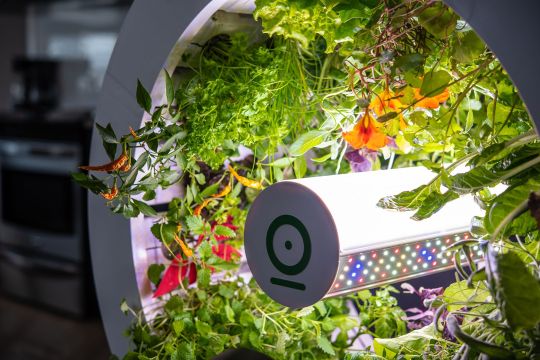
Transform your living space into a lush oasis of greenery and tranquility with a carefully designed smart indoor gardening system. Explore the key elements to consider when designing your indoor garden and discover how to create a harmonious and thriving environment for your plants.
Choosing the Right System: Selecting the perfect Smart Indoor Gardening System is the first step in creating your oasis. Consider factors such as size, style, and functionality to find a system that fits seamlessly into your home.
Whether you opt for a countertop herb garden, a vertical hydroponic setup, or a fully automated indoor greenhouse, choose a system that suits your space and gardening preferences.
Selecting Plants and Layout
Once you've chosen your system, it's time to select the plants that will inhabit your indoor garden. Consider factors such as light requirements, growth habits, and aesthetic appeal when choosing your greenery.
Experiment with different plant combinations and layouts to create visual interest and balance in your indoor garden, incorporating a mix of herbs, vegetables, and ornamental plants to suit your tastes.
Optimizing Light and Environmental Conditions
Light is essential for plant growth, so it's important to ensure that your indoor garden receives adequate illumination. Assess the natural light conditions in your home and supplement as needed with artificial lighting.
Position your indoor garden near windows or under grow lights to provide your plants with the optimal amount of light for healthy growth, and monitor environmental conditions such as temperature and humidity to create a comfortable and conducive environment.
Customizing Your System
Personalize your smart indoor gardening system to reflect your unique style and preferences. Add decorative elements such as planters, trellises, and decorative accents to enhance the visual appeal of your indoor garden.
Incorporate smart features such as automated watering systems, nutrient monitors, and remote control capabilities to streamline maintenance and ensure the health and vitality of your plants.
Creating a Maintenance Routine
Regular maintenance is key to keeping your indoor garden thriving. Develop a maintenance routine that includes tasks such as watering, pruning, and fertilizing to keep your plants healthy and happy.
Set reminders or schedule automated tasks to stay on top of maintenance chores, and take time to observe and interact with your plants to monitor their progress and address any issues that arise.
Designing your smart indoor gardening system is an opportunity to create a personalized oasis that brings beauty, tranquility, and vitality into your home. By carefully selecting plants, optimizing environmental conditions, and customizing your system to suit your style and preferences, you can create an indoor garden that nourishes the body, mind, and soul.
Get More Insights On This Topic: Smart Indoor Gardening System
#Smart Indoor Gardening System#Indoor Agriculture#Home Gardening Tech#Urban Farming#Automated Plant Care#Hydroponics#Indoor Herb Garden#Smart Home Devices#Sustainable Living
0 notes
Text
If you have been associated with farming or agriculture recently, you might have encountered the term known as hydroponics. It cultivates plants in nutrient-rich water, with any medium like soil, sand, or gravel.
Hydroponics is derived from the Greek word hydro, which means water, and ponos, which means labour. Together, they come as the cultivation that supports plant growth in the vertical position that holds the moisture and oxygen the plant will need.
#hydroponic farming#vertical hydroponic system#indoor lettuce grower#hydroponic farming at home#hydro farming#hydroponic container#best vertical hydroponic system#farm stand hydroponic
0 notes
Text
The Comprehensive Guide to Growing Hydroponic Strawberries in Desert Climates
Welcome to our in-depth exploration of growing hydroponic strawberries in the heart of the desert—a challenging yet immensely rewarding endeavor for gardeners and agricultural enthusiasts alike. Imagine, lush, ripe strawberries thriving in an environment known for its arid landscapes and scorching heat. This juxtaposition is not just a dream, but a reality made possible through the wonders of…

View On WordPress
#climate-adapted gardening#desert gardening#Eco-Friendly Gardening#fruit cultivation#gardening in arid climates#home hydroponics#hydroponic strawberries#Hydroponic systems#innovative farming techniques#nutrient management#Soil-less cultivation#strawberry varieties#sustainable agriculture#urban farming#water-efficient farming
1 note
·
View note
Text
Hydroponic Farming at Home
Hydroponic farming is a soilless farming technique that has gained popularity in recent years due to its numerous benefits. With hydroponics, it is possible to grow a wide variety of plants, including fruits, vegetables, herbs, and flowers, using water and nutrient-rich solutions. This innovative approach to agriculture is not only sustainable and cost-effective but also allows for year-round cultivation regardless of location or climate.
Higronics is a company that specializes in hydroponic farming solutions for home use. They offer a range of products that cater to both beginner and experienced hydroponic enthusiasts. One of their main products is a compact hydroponic system that can be easily set up in small spaces such as apartments, balconies, and rooftops.
The Higronics hydroponic system consists of a reservoir, pump, grow tray, and nutrient solution. Plants are placed in net cups, which are suspended above the nutrient-rich water, allowing the roots to absorb the necessary nutrients. The system is fully automated, with a timer that controls the pump, ensuring that the plants receive the right amount of water and nutrients at the right time.

One of the advantages of the Higronics hydroponic system is its efficiency. Since the system recirculates water and nutrients, it uses up to 90% less water than traditional soil-based farming. The system is also designed to be energy-efficient, using LED grow lights that consume minimal electricity.
Another benefit of hydroponic farming with Higronics is that it allows for faster and more abundant plant growth. The system provides a controlled environment, with optimal temperature, pH levels, and nutrient levels. This results in healthier plants that grow faster and yield more produce than traditional farming methods.
Hydroponic farming with Higronics also offers the advantage of being able to grow a wide variety of plants in a small space. With the right setup, it is possible to grow multiple crops at the same time, increasing productivity and maximizing space utilization.
0 notes
Text
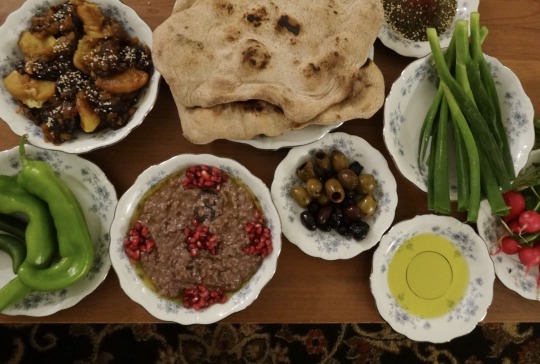
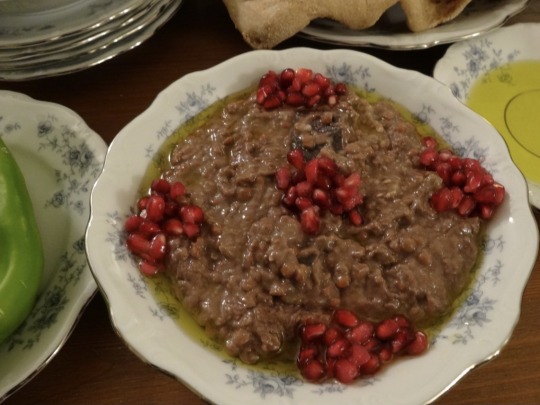
[ID: A purplish-grey stew topped with olive oil and garnished with piles of pomegranate seeds. Plates of green peppers, bitter olives, olive oil, taboon bread, green onions, radishes, and za'tar surround the dish. The second image is a close-up of the same stew. End ID]
رمانية / Rummāniyya (Palestinian pomegranate stew)
Rummaniyya (رُمَّانِيَّة; also transliterated "rumaniyya," "rummaniya," and "rummaniyeh") is a Palestinian stew or dip made from lentils, eggplant, and pomegranate seeds, flavored with nutty red tahina and a zesty, spicy دُقَّة (dugga) of dill seeds, garlic, and peppers. A طشة (ṭsha), or tempering, of olive oil and onion or garlic is sometimes added.
"Rummaniyya," roughly "pomegranate-y," comes from رُمَّان ("rummān") "pomegranate," plus the abstract noun suffix ـِيَّة ("iyya"); the dish is also known as حبّة رُمَّانَة ("ḥabbat rommāna"), or "pomegranate seeds." It is a seasonal dish that is made at the end of summer and the beginning of fall, when pomegranates are still green, unripe, and sour.
This stew is considered to be one of the most iconic, historic, and beloved of Palestinian dishes by people from Gaza, Yaffa, and Al-Ludd. Pomegranates—their seeds, their juice, and a thick syrup made from reducing the juice down—are integral to Palestinian cuisine and heritage, and images of them abound on ceramics and textiles. Pomegranates and their juice are sold from street carts and cafes in the West Bank and Gaza.
Today, tens of thousands of tons of pomegranates are grown and harvested by Israeli farmers on stolen Palestinian farmland; about half of the crop is exported, mainly to Europe. Meanwhile, Palestinians have a far easier time gaining permits to work on Israeli-owned farms than getting permission from the military to work land that is ostensibly theirs. These restrictions apply within several kilometers of Israel's claimed borders with Gaza and the West Bank, some of the most fertile land in the area; Palestinian farmers working in this zone risk being injured or killed by military fire.
Israel further restricts Palestinians' ability to work their farms and export crops by imposing tariffs, unexpectedly closing borders, shutting down and contaminating water supplies, spraying Palestinian crops with pesticides, bulldozing crops (including eggplant) when they are ready to be harvested, and bombing Palestinian farmland and generators. Though Palestinian goods have local markets, the sale of Palestinian crops to Israel was forbidden from 2007 to 2014 (when Israel accepted shipments of goods including tomato and eggplant).
Gazans have resisted these methods by disregarding orders to avoid the arable land near Israel's claimed borders, continuing to forage native plants, growing new spices and herbs for export, planting hydroponic rooftop gardens, crushing chalk and dried eggplants to produce calcium for plants, using fish excrement as fertilizer, creating water purification systems, and growing plants in saltwater. Resisting Israeli targeting of Palestinian food self-sufficiency has been necessary for practical and economic reasons, but also symbolizes the endurance of Palestinian culture, history, and identity.
Support Palestinian resistance by calling Elbit System's (Israel's primary weapons manufacturer) landlord; donating to Palestine Action's bail fund; and buying an e-Sim for distribution in Gaza.
Serves 6-8.
Ingredients:
For the stew:
1 medium eggplant (370g)
1 cup brown lentils (عدس اسود)
600g pomegranate seeds (to make 3 cups juice)
3 Tbsp all-purpose flour
1/4 cup red tahina
1/2 cup olive oil
Salt, to taste
Citric acid (ملح الليمون / حامِض ليمون) (optional)
Red tahina may be approximated with home cooking tools with the above-linked recipe; you may also toast white tahina in a skillet with a little olive oil, stirring often, until it becomes deeply golden brown.
For the دُقَّة (dugga / crushed condiment):
2 tsp cumin seeds, or ground cumin
1 1/2 Tbsp dill seeds ("locust eye" بذور الشبت / عين جرادة)
5 cloves garlic
1 green sweet pepper (فلفل بارد اخضر)
2 dried red chilis (فلفل شطة احمر)
People use red and green sweet and chili peppers in whatever combination they have on hand for this recipe; e.g. red and green chilis, just green chilis, just red chilis, or just green sweet peppers. Green sweet peppers and red chilis are the most common combination.
For the طشة (Tsha / tempering) (optional):
Olive oil
1 Tbsp minced garlic
Instructions:
1. Rinse and pick over lentils. In a large pot, simmer lentils, covered, in enough water to cover for about 8 minutes, or until half-tender.
2. Meanwhile, make the dugga by combining all ingredients in a mortar and pestle or food processor, and grinding until a coarse mixture forms.
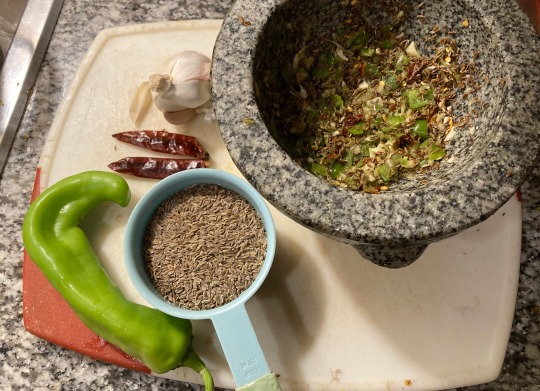
Dugga and components.
3. Cube eggplant. A medium-sized eggplant may be cut in half lengthwise (through the root), each half cut into thirds lengthwise, then cubed widthwise.
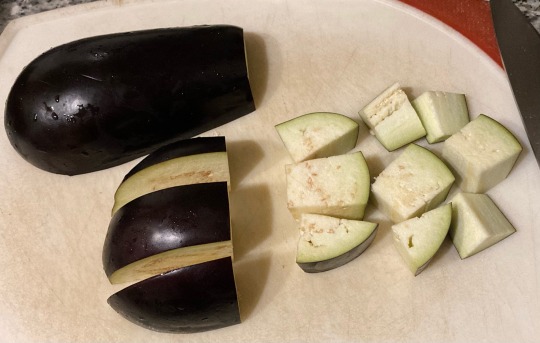
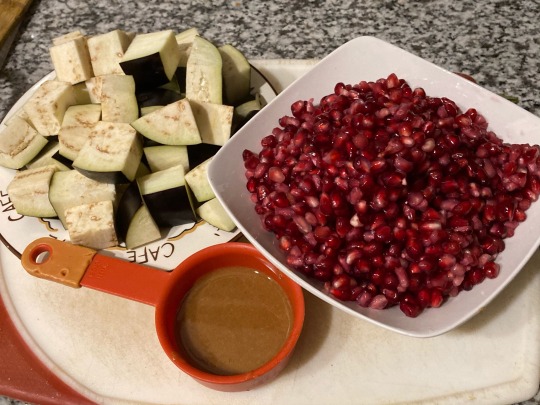
Cubed eggplant, red tahina, and pomegranate seeds.
4. Add eggplant to simmering water (there is no need to stir).
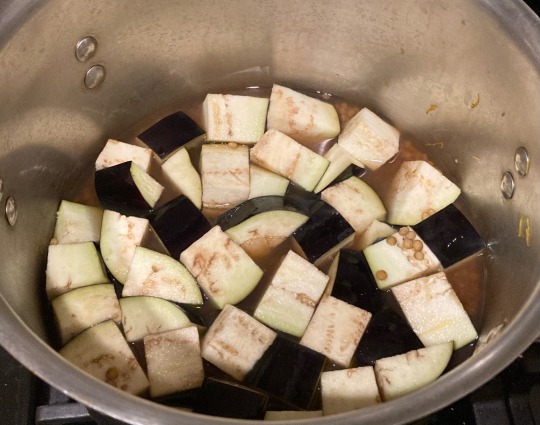
5. While the eggplant cooks, blend pomegranate seeds in a blender very thoroughly. Strain to remove any gritty residue. Whisk flour into pomegranate juice.
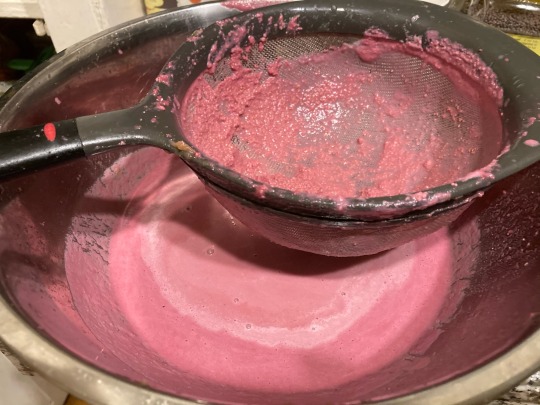
Pomegranate juice being strained.
6. Taste your pomegranate juice. If it is not sour, add a pinch of citric acid or a splash of lemon juice and stir.
7. Add dagga to the pot with the lentils and eggplant and stir. Continue to simmer until the eggplant is very tender and falling apart.
8. Add pomegranate juice, tahina, and olive oil to the pot, and simmer for another 5 minutes, or until stew is very thick and homogenous.
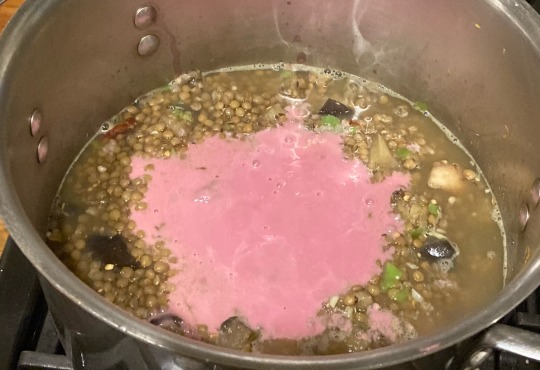
Bright pink pomegranate juice in stockpot.
9. (Optional) In a small skillet, heat a little olive oil on medium. Fry minced garlic, stirring constantly, until golden brown. Add into the pot and stir.
10. (Optional) Mash the stew with the bowl of a ladle or a bean masher to produce a more homogenous texture.
Serve rummaniyya hot or cold in individual serving bowls. It may be served as an appetizer, or as a main dish alongside flatbread, olives, and fresh vegetables such as radishes, green peppers, green onions, carrots, and romaine lettuce. It may be eaten with a spoon, or by using كماج (kmāj), a flatbread with an internal pocket, to scoop up each bite.
572 notes
·
View notes
Text


Maybe as a reward for repairing his friend, the creature showed Jack the hydroponics! The Boys are slowly running out of stocks - plus they have an additional (heavy) eater on board now ö.ö
The plants here are well cared of by the devices and bots - and already harvestable! Jack is fascinated by everything space and scifi and exploring alien plants is a long-held dream of his ^^' Jack called Jeb over, since the two of them are in charge of their greenhouse and garden at their home too. Jeb was still trying to repair the ship, but food has priority atm. He's is not quite as excited as Jack...

Jeb: "Only - we don't know any of these flora - and if they're edible. Sure, some of the harvestables look familiar, but they grow on these unfamiliar plants..." But he started to research anyway ^^'

Jack spotted the Sixam Fly Trap: "Well, I surely remember this little guy!"

(The Boys had a Sixam Fly Trap at the Invisible Farm in Summer 2023. Jack thought it was cute that it looked like Saiwa and he teased him with a photo of it ^^') It looks like this when it just snapped a fly. Being proud of himself.

'I've given you southern exposure To get you to thrive I've pinched you back hard Like I'm s'posed ta You're barely alive I've tried you at levels of moisture From desert to mud I've given you grow-lights And mineral supplements What do you want from me, blood?'
Little Shop of Horrors - Grow for me The MV linked above is from the Movie and the cutest thing!
Jack took a photo of this one too: "It's so cute! We could put the photo in your quarters." But Jeb stopped him. Sai is already stressed enough... (The post-it below the photo says: "Captain Saiwa II. Just as sharp-toothed and snappy as his namesake.")

Great A'Tuin's communication system still doesn't work (good job, alien creature...), so they have no access to external data or intergalactic search engines. But they could check the ship's internal database. And that's what they did. There they are! Sheets with information about all of the plants (created by Albaleyh herself when she used to work here). And they are all classified as edible. Some are even of medical use! Jeb: "After we resolved the food issue, we could check if any of them could be of help for Ji Ho's travel sickness!" Jack: "That would be awesome!"

Jeb and Jack picked a few of the strange vegetables and fruits and went over to the kitchen. Great A'Tuin's database even offers recipes and information about how to prepare them and which parts to use. Jack: "I really hope we don't end up like the poor little guys in those jars after eating these dishes... But somehow we'll have to find out if we can really eat them - and survive." For a moment Jeb considered if he should say goodbye to Saiwa before dinner ö.Ö'

But then the 'Curious Pizza' was ready to eat and Jack couldn't wait to taste it. It's been too long. Jack loves his pizza, no matter the toppings ^^'

Jeb: "Eh... if something happens. Tell Saiwa I love him." Jack: "Hey, let's keep a little optimism here!"


Lol, Jeb set the table with a flask of medicine for each ^^'

(And, of course, Jack refused to eat sitting at the table -.- I already replaced the tables and locked the door. Last time Kiyoshi and Jack ran outside... Next time I'd locked the door and they sat to eat on the cooler box or ate while standing omg... I mean, they already sit and have the food in front of them, why pick it up and go somewhere else?)

Jack: "But it was quite delicious! If we die, we die satisfied and well sated, hm?" If you have a friend like Jack, you don't need no enemies hahaha

Outtakes
Jack already had a stressful day. And on top of that, Greg called him ^^' He surely does not want to be like Greg - ever! And the only one to ever put an effort in trying to raise Jack was Uncle Stefan. (And Saiwa hahaha)

And then the first of his 'Curious Pizza' vanished right from the oven! So he had to make another one... Maybe the creature will find it ^^' Or the Boys - when it starts to smell ö.ö (I already wondered why Sai is complaing in the pic above. There is no dirt ö.ö (edit: It was a bunch of hairs from the cat creature, which was just as grey as the spaceship's floor...)

From the Beginning 🔱 Underwater Love 🔱 Latest
Current Chapter: starts ▶️ here Last Chapter: 'Here comes the Sun' from the beginning ▶️ here
📚 Previous Chapters: Chapters: 1-6 ~ 7-12 ~ 13-16 ~ 23-29
#underwater love#Piglets in Space#jack callahan#Lenny Andromedan#jeb harris#Great A'Tuin II#Jack pizza#simlit#Jack hates Greg#sims 4 story#sims story#the sims 4#simblr#sims 4#ts4 story#ts4
33 notes
·
View notes
Text
figured i would do a quick write-up about JADAM farming techniques since there's only one post about it that I could find on tumblr and you're not likely to find a more niche subset of organic farming-
TL;DR: JADAM is a korean grassroots organic farming method that uses 3 recipes (a soil microbiome solution, a pest/disease control solution, and a surfactant) to increase yields cheaply and organically, scalable to both small-scale gardens as well as industrial agriculture.
youtube
Above is the inventor's youtube channel, and although most content is in Korean, it has enough English-language instructional content to get the basic idea across.
The most interesting aspect to me is the JMS (JADAM Microorganism Solution) that improves the soil microbiome and and nutritional diversity. By blending and steeping leaf mold, salt, and boiled mashed potatoes, you can make an entire drum of intense living fertilizer in a few days.
The JADAM sulfur solution that is used as pesticide is less convenient for a small home gardener due to the inherent risk of inexperienced gardeners creating chemical reactions with sulfur and caustic soda, but if utilized on an industrial scale could cut back pesticide usage so significantly.
I believe that large scale organic farming is too focused on hydroponic growing due to FDA/USDA organic restrictions being so inflexible, and that a revolution in the organic scene is necessary to allow for "true" (non-hydroponic) organic growers to continue existing, and the JADAM system offers a cheap and effective way of farming organically.
The JADAM "Ultra-Low-Cost Agriculture" philosophy is an ideal organic agricultural system, and I really hope it starts to get more attention outside of Korea so that we can more closely examine its feasibility.
#JADAM#organic gardening#organic fertilizer#gardening#gardenblr#plantblr#farming#vegetables#solarpunk#Youtube#Korea#Agriculture
22 notes
·
View notes
Text
Automated Aquaponics Outdoors 1 Month Progress
Explore the incredible 1-month transformation of an automated outdoor aquaponics system in action! Witness fish thriving in a sustainable aquatic environment, their waste fertilizing vibrant grow beds filled with healthy vegetables and herbs. This self-sustaining system showcases the perfect harmony between aquaculture and hydroponics, minimizing labor while maximizing growth. A glimpse into the future of eco-friendly farming. 🌱🐟♻️
Download our FREE PDF 9 Tips to Instantly Become Lazy Sustainable Guide:
Unimother exists to make the consumer the producer of food. The production of food destroys rainforests, and water bodies and kills insects. Nonetheless, we create 1.3 TRILLION KG of food waste EVERY YEAR. We are working to eliminate the biowaste in every home through black soldier fly larvae, producing protein, fat, fertilizer, and water automatically. Making food scraps a new source of food and material while eliminating transport, plastic packaging, and deforestation. #viral #fyp #fy #sustainability #wastefree #wasteremoval #trash #environment #plasticfree #shorts
#aquaponics#animals#livestock#aquatic life#fish#food waste#sustainable#wasteremoval#food#fish tank#fishes#aquatic
2 notes
·
View notes
Text
ANOMALY: Homeworld Part Three
Putting a break here because this is a long one.
Earth Humanity
Before: Earth was a failing planet a century before humanity would ever even begin to dream of first contact. Corporate greed fed into the slow death of humanity's original home, and eventually that greed became too much to bear. Corporate consolidation of power led to many governments either bending the knee to the financial conglomerate, or being quietly wiped off the map.
The desire for power reached beyond humanity's means, leading to innovation and advancement. Cybernetic augmentation became commonplace and was heavily monetized along with all other luxuries and necessities.
Soon, Earth proved itself to not be enough for the unceasing hunger for more and the conglomerates turned their eyes to the rest of the solar system. The moon was the first and most obvious target, its stores of Helium-3 would be needed if expansion was to continue. The first extraterrestrial mining colony would be established alongside a residential leisure colony designed to house only the most powerful. This lunar colony was not only made as a place of status but as a haven from the dying Earth whose changing climate and rising seas were becoming too much of an unpredictable threat.
The expansion into space would continue advancing moving from the moon to Venus where new mining efforts would continue and the first stages of terraforming would begin.
The next stage in expansion pushed humanity to Mars, the one place humans had dreamed of inhabiting for centuries. The red planet would prove to be hostile and terrible place to live, but compared to the worsening situation back on Earth, the Martian colonists believed they had it easy. The first round of colonists were preceded by a giant team of robots that laid the ground work for eventual human arrival; constructing habits and building hydroponic farms to ensure as little difficulty for the first Martians.
Back on Earth, life was horrid for those that had no influence or money. Billions of people starved or worked themselves to death under the heels of The Conglomerate just to survive a little longer. Those that were lucky had their names placed in a lottery for future extraterrestrial colonization efforts. Many of the people living in squalor even opted to place themselves in indentured servitude with corporate colonization teams just to escape the slow hell of Earth.
With its expanding population and growing major colonies, Mars was quickly becoming the new best place to live. The first - and largest - colony would eventually be renamed "Opportunity" after one of the ancient robots that had scouted the planet it humanity's pre-conglomerate days; other colonies would follow suit with their names.
The distance between Mars and The Moon/Earth was a hard gap for the influential and powerful to continue bridging especially when accounting for their desire to keep Mars under Conglomerate control. This gap in management capability and Conglomerate control would be exploited with Martian workers using the travel and communication delay to ease the burdens of their own lives.
The exploitation of Martian workers would reach a boiling point almost a century after Opportunity's foundation. The Conglomerate had managed to create faster and more efficient ships and means of communication, bridging the gap and allow them to slowly strangle the population of Mars for more gain. Martians were built tough, though, and many of those now living on the planet were born there. The native born grew tired of answering to an oppressive outside force, so they fought back. The Martian revolution would last for nine standard years and in that time, many settlements would be wiped out and the population of Opportunity would be decimated, but the Martians would win, killing the Conglomerate heads living on the planet and driving back those that came from the outside.
The Conglomerate would leave Mars to its fate. Many of the higher ups believed that Martians would slowly die off without support from Earth, and they couldn't have been more wrong.
Inspired by their fellow extraterrestrials, other colonies would also seek emancipation from the Conglomerate and would win their freedom easy as the Conglomerate had stretched itself too thin fighting on too many fronts.
Once again, back on Earth, the situation only worsened. Many saw the way the Martians, Venusians and other colonists fought back against the Conglomerate and this fed the Earthborns' rage. They too fought back, but to no success. The Conglomerate knew an Earth revolution would come sooner or later, especially after losing their grip on their most essential colonies. The Conglomerate, in the first stages of the domestic revolution, quietly moved its most important employees into a flotilla of starships that would leave Earth behind.
The plot to abandon the planet was found and the revolution targeted the ships. Only a few of the ships managed to escape earth in the slaughter of the flotilla and those that escaped decided to finish their plan. The Earth was bombarded with nuclear weapons, killing billions of people and turning the planet into an uninhabitable wasteland. Those escaped ships would not survive much longer as the parts of the flotilla that had been captured by the revolution were in pursuit and they were angry. The ships were boarded and the last of the Conglomerate was killed.
What remained of humanity now lived beyond their original home. The flotilla tried to seek asylum with Mars and Venus but both planets would not afford to suddenly take in thousands of survivors. The colonies did give the Flotilla the means to become self sufficient and continue to survive.
In the century that followed, what remained of humanity would work together, trading and forming The Solar Alliance. Eventually, a group of researchers from the University of Opportunity would mysteriously receive ground breaking information about something known as "the reverse" and it would change humanity's course forever.
After: Humans took to the stars as quickly as they could, but they did not expect that their first venture into another solar system would also be the first time they make contact with an alien species.
Greeted with open arms by the Shaza, humanity was quickly told everything they needed to know about the reverse, the galaxy and the nearby stars that were home to habitable worlds. Additionally, the Shaza forced their way onto Mars and Venus, deploying much more sophisticated terraforming technology that helped the planets see more progress in a few decades than in the centuries before.
Earth however, it remained as it was: an uninhabitable hellscape seen by humanity as a good lesson of what happens when greed wins. Efforts to restore the planet were refused as much of humanity no longer wished to live on their ancestral home. Earth was declared a nature preserve and attempting to land on the planet is treated as a serious crime. Those who dared to break the law and visit the old homeworld have spread rumors that the Armageddon did not kill everyone and the descendants of its survivors still roam the ruined lands of the old world.
Tag List:
@capnmachete @leahnardo-da-veggie @tamiveldura @lorifragolina @liminalgoddessworld
@humbleartspawn @orion-lacroix @insecure-pilot @xenascribbles
#ANOMALY#writeblr#writers on tumblr#writers of tumblr#author#creative writing#science fiction#scifi#worldbuilding#sci fi
4 notes
·
View notes
Text
Experience Fresh and Abundant Harvests with the Innovative Home Hydroponic Farming System
The Home Hydroponic Farming System boasts a range of impressive specifications that make it a game-changer in the world of indoor gardening. This compact and user-friendly system is designed to fit seamlessly into any home environment. Its dimensions of [insert dimensions] ensure that it can be placed conveniently in your kitchen, balcony, or even a small spare room.
0 notes
Text
Find the Best Hydroponic NFT Channel | Inhydro

The Inhydro complete indoor hydroponic grow system is a great way to begin your hydroponic gardening journey. This system utilizes a Hydroponic NFT channel for its nutrient delivery method, ensuring that the plants get all the essential nutrients they need to thrive.
#hydroponic companies in india#Hydroponic Farming India#Hydroponic Farming at Home#Hydroponics Training in Delhi#Hydroponic Training Courses#Hydroponic Farming Equipment#Best Indoor Hydroponic Plants#Hydroponic Plants Indoor#Small Hydroponic System#Hydroponic Home Setup#Hydroponic Hobby Setup#Hydroponic Grow kit#Hydroponic NFT Channel
2 notes
·
View notes
Text
[Memory: Escape]
The Domes underneath Octo Valley had begun deteriorating again after the Inklings defeated DJ Octavio and stole the Great Zapfish that the DJ had convinced to help provide energy.
The farming Dome that Soda lived in was no exception. In fact, they were almost worse off than neighboring Domes. The sun lamps for the crops required high amounts of power, and the limited budget meant that sacrifices must be made.
Soda had been pulling extra hours in the hydroponics farm, both to stay out of his dark living quarters and because they were increasingly short-handed as Octolings fled to the surface.
After shift walks and a network of rumors has allowed him to gather information on the increased security patrols. The info got spottier the closer to the surface it came from, from the game of telephone downwards and false info planted to lead defectors into security ambushes.
Tonight would be his escape. He had managed to scrounge together a flashlight, some batteries, and a weapon. The shooter was weak, only meant for defense in case of Inkling invasion. No match for the splatterpower that security had.
Slipping through the back hallways, Soda was able to make his way through the first few Domes without attracting the attention of security. The last Dome along his path was the most dangerous, housing a large security outpost for the direct purpose of restricting access to the surface via highly trained Octoling officers.
Testing in his home Dome had given him an idea of what angles the cameras cover, where checkpoints might be more common, and where ventilation systems will lead.
Soda managed to get past the security. In front of him was a tube that would bring him to the surface.
"HEY!"
Soda looked back. Two guards, a security patrol team. Soda drew his puny inkshooter, causing one of the guards to aim her service splattershot at him. He was shaking like a leaf, knowing full well that he had no hope of surviving a fight against two officers.
Then the other security officer grabbed her partner's arm. She looked back in confusion and a small argument began between the two. Soda took the opportunity to dash into the tube line and escape.
Soda was awestruck by the stars hanging in the night sky above. It was brighter out here than in his Dome when they shut off the walkway lights at night. Inkling Turf was to the south, so he began heading that way. One of the caves through Mt. Nantai would bring him across the border.
At the mountain, the plan fell apart and the memory becomes a blur of ink and rock, a mad dash through the dark, praying that he doesn't hit a dead end.
6 notes
·
View notes
Text
/ FOREIGN SYSTEM OVERRIDE DETECTED / / TRIANGULATING ORIGIN OF TRANSMISSION / / > Returned Transmission Vector: / > - SB01AL, Orassian Order of Templars / > - V07KNA, Unclaimed Sector / > - VLEI1Q, Unclaimed Sector / > - BN264L, Raxing Oligarchy / > - R1PDN9, Unclaimed Sector / > - RYN7A4, Alari Interstellar Commonwealth / > - D58KA1, Vegvian Nomad Fleet / > - RPWN16, Interstellar Union of Combine Colonies / > - 001L39, The Elepharchy / > - 10DL1V, Interstellar Union of Combine Colonies / TRIANGULATION SUCCESSFUL / / ORIGIN CONFIRMED: Interstellar Union of Combine Colonies / / MATRIARCH HAS BEEN INFORMED / / MATRON COUNCIL HAS BEEN INFORMED / / ORASSIAN HIGH COMMAND HAS BEEN INFORMED / / ORASSIAN GUN REPRESENTATIVE HAS BEEN INFORMED / / HOMING ONTO THE INCOMING TRANSMISSION /
Testing reception... 1... 2...
Oh... It seems that the origin of our transmissions has been discovered by our rivals. I suppose it was only a matter of time. It's doubtful the Matriarchy has the technical means to stop our broadcasts from entering into their space, unless they have allies as powerful as we do.
Let us turn on the visual feed. Our studio has changed a little for the upcoming occasion.
/ ENABLING CATCH PROTOCOLS FOR VISUAL FEED /

Yshiradh, Orassian nation and aliens from the beyond! I'm Erhrdra D'Kara, the hostess of 'People's News Republic'. We're an independent news agency geared towards unbiased coverage about current events happening in the Orassian space.
A significant event for the entire nation happened several weeks ago when the partisans from the 'Orassian Liberation Front' and the 'Insurgent Priesthood Organisation' successfully stormed main military headquarters of Atasaŋ city. All military units of the enemy had been pacified, and the heavy artillery and infantry stored within was put to use by the insurgents.
During the next few weeks, the OLF and the IPO liberated the entire city and approx. 55% of the entire H'Oumukh Region of Prophet's Promise, which is quite unprecedented in the recent history. By all means, the entire nation had witnessed the start of a large-scale civil war.
The Matron Council and the Matriarch had declared a state of emergency and will be mobilizing all military assets to put and end to the fast-growing insurgency movement. But, the OLF/IPO remain optimistic, stating their experience in building robust defenses.

(For the purposes of clarity, all of the natural blockers have been omitted from view.)
The fighting hadn't started just on the capitol world, however. Local insurgent cells on J'Kir's Jewel, the terraforming base of Prophet's Promise, rose up to the occasion and claimed two habitation domes in the eastern hemisphere of the moon. One of them is a civilian-class farming and hydroponics facility and the other is a fortress-class overwatch dome. The revolutionaries quoted the events in H'Oumukh Region as a direct inspiration for their actions.

It appears that a lot had been happening behind the scenes. The 'Orassian Liberation Front' had reportedly struck a deal with the disgruntled administration of the Resource Extraction Sector. The latter was being heavily taxed by the Matriarchy in attempt to hoard minerals and strategic resources for themselves, as they no doubt anticipated the rise of the insurgents.
The Central Habitat Complex of the sector's administration had been retrofitted to serve as the HQ for the Orassian Liberation Front, opening a new space frontier.

Currently, in context of recent events, our correspondents report heavy fighting happening in the northern system of the Orassian space. The insurgents are being hammered by the Matriarchy's assault fleet divisions. The former are resorting to hit-and-run tactics to exhaust the opponent, while slowly striking at the starbase with particle lances.

We anticipate that there will be a lot to cover in the coming weeks, though it's unclear how much we will be able to reveal in order not to compromise the OLF's intelligence departments. What is certain, however, is that this is a pivotal point for the entire nation and the start of our fight for democracy.
For tonight, that is all. This has been 'People's News Republic'.
Truth to the people. Freedom to the oppressed. Remembrance to the fallen.
/ TRANSMISSION END /
8 notes
·
View notes
Text
What plants can be grown hydroponically?
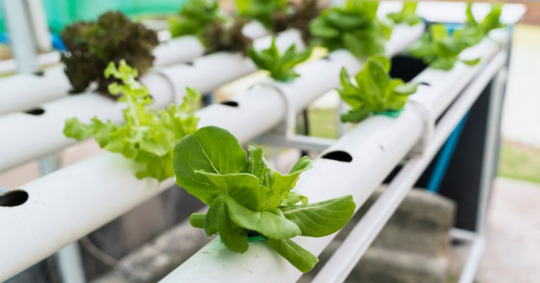
In the world of modern agriculture, hydroponic gardening has emerged as a revolutionary method of cultivating plants without soil, using nutrient-rich water solutions. This innovative approach offers numerous advantages, including efficient resource utilization, faster growth rates, and the ability to grow crops in environments where traditional farming may not be feasible. Among the myriad of plants that can thrive in hydroponic systems, some stand out for their adaptability and productivity.
Leafy Greens: Lettuce, spinach, kale, and other leafy greens are some of the most popular choices for hydroponic cultivation. They have shallow root systems and high water requirements, making them perfectly suited for nutrient-rich water environments. With the right hydroponic setup, these greens can be grown year-round, providing a consistent supply of fresh produce.
Herbs: Basil, cilantro, mint, and parsley are excellent candidates for hydroponic growth. These aromatic herbs flourish in controlled hydroponic environments, offering superior flavor and quality compared to their soil-grown counterparts. Hydroponic herb gardens are ideal for culinary enthusiasts seeking a convenient and sustainable source of fresh herbs.
Tomatoes: Tomatoes are another popular choice for hydroponic cultivation. They thrive in nutrient-rich solutions and benefit from the support of trellises or vertical systems. Hydroponically grown tomatoes often exhibit enhanced flavor and texture, making them a favorite among home gardeners and commercial growers alike.
Cucumbers: Cucumbers are well-suited for best hydroponic systems, particularly when grown vertically to maximize space efficiency. With proper support structures and nutrient delivery, hydroponic cucumbers can produce abundant yields of crisp, flavorful fruits throughout the growing season.
Peppers: Bell peppers, chili peppers, and other varieties can thrive in hydroponic environments. These plants require consistent moisture and nutrient levels, which can be easily maintained in hydroponic systems. With proper care, hydroponically grown peppers can yield bountiful harvests of vibrant, flavorful fruits.
Strawberries: Hydroponic strawberry production has gained popularity in recent years due to its ability to maximize space and optimize growing conditions. By utilizing vertical towers or hanging systems, growers can cultivate strawberries without soil, leading to cleaner, healthier fruits and increased yields.
Microgreens: Microgreens are young, tender greens harvested at an early stage of growth. They are packed with nutrients and flavor, making them a popular choice for salads, sandwiches, and garnishes. Hydroponic systems offer an efficient means of producing high-quality microgreens year-round, providing chefs and home cooks with a continuous supply of fresh, nutritious greens.
Potatoes: While traditionally grown in soil, potatoes can also be cultivated hydroponically, especially in potato vertical farming systems. With proper tuber support and nutrient delivery, hydroponic potatoes can yield impressive harvests in a fraction of the space required for conventional soil cultivation. Vertical farming techniques optimize space utilization, making them ideal for urban agriculture and limited land environments.
When it comes to choosing the best hydroponics system for growing these plants, several factors should be considered, including available space, budget, and desired crop varieties. Vertical farming systems, such as tower gardens or vertical hydroponic racks, offer an efficient solution for maximizing space and increasing yields. These systems allow growers to stack multiple layers of plants vertically, optimizing space utilization and productivity.
Hydroponic gardening offers a versatile and sustainable approach to cultivating a wide range of plants, from leafy greens and herbs to tomatoes, cucumbers, and even potatoes. By harnessing the power of nutrient-rich water solutions and innovative growing techniques like vertical farming, growers can achieve impressive yields of high-quality produce year-round. Whether for commercial farming operations or home gardening enthusiasts, hydroponics represents a promising frontier in modern agriculture, paving the way for increased food security and environmental sustainability.
#hydroponic gardening#hydroponic plant growth#hydroponic syteam#hydroponic plant#hydroponics store near me#vertical hydroponic garden#hydroponic garden tower#hydroponic tower garden#hydroponic lettuce#hydroponic tomatoes#hydroponic seeds#hydroponics tower#aquaponics vs hydroponics#general hydroponics#hydroponic planter#hydroponic nutrients#hydroponic weed#hydroponics for weed#hydroponic strawberries#hydroponic fertilizer
3 notes
·
View notes